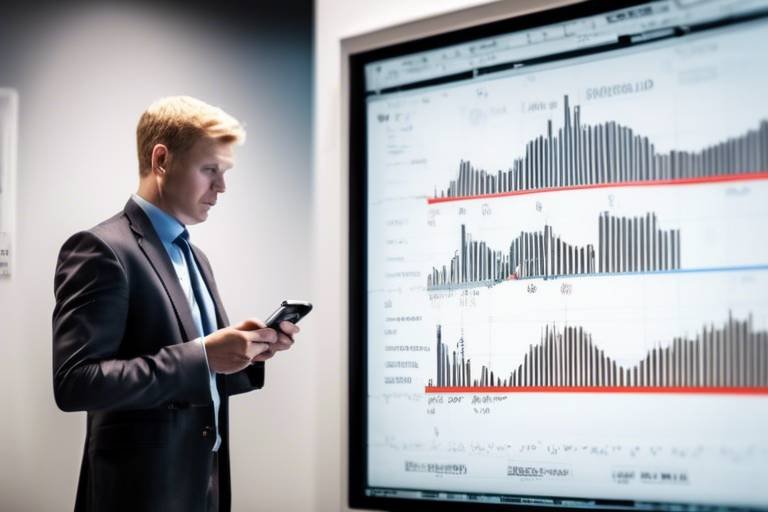The Impact of Technical Indicators on Crypto Trading
The world of cryptocurrency trading is akin to navigating a vast ocean of opportunities and risks. Just like a sailor relies on navigational tools to steer through unpredictable waters, traders depend on technical indicators to guide their decisions in this volatile market. But what exactly are these indicators, and how do they influence trading strategies? In this article, we'll dive deep into the realm of technical indicators, exploring their effectiveness, the potential pitfalls, and how they can shape your trading journey.
Technical indicators are not just random numbers or graphs; they are mathematical calculations derived from price, volume, or open interest data. Think of them as the compass and maps that help traders make sense of the chaotic crypto landscape. By analyzing these indicators, traders can identify patterns, trends, and potential reversals, allowing them to make informed decisions rather than relying solely on gut feelings.
However, it's crucial to understand that while technical indicators can be incredibly powerful, they are not foolproof. The crypto market is notorious for its unpredictability, and even the most reliable indicators can lead traders astray if misinterpreted. Therefore, it's essential to approach them with a critical eye and combine them with sound risk management strategies.
In the following sections, we'll break down the different types of technical indicators, how they can be used effectively, and the common mistakes traders make when relying on them. By the end of this article, you'll be better equipped to navigate the choppy waters of crypto trading.
At their core, technical indicators serve a singular purpose: to assist traders in making informed decisions. These indicators analyze historical data and provide insights into market trends. Imagine you're trying to predict the weather; you wouldn't rely on just a single data point, right? You'd look at temperature, humidity, wind speed, and more. Similarly, traders use various indicators to paint a clearer picture of market conditions.
There are several categories of technical indicators, each serving a unique purpose in the trading process. Understanding these categories is vital for developing a robust trading strategy. Here are the main types:
- Trend Indicators: Help identify the direction of the market.
- Momentum Indicators: Measure the speed of price movements.
- Volatility Indicators: Assess market fluctuations.
- Volume Indicators: Analyze trading volume to confirm trends.
Trend indicators are like a lighthouse guiding ships to safety; they help traders identify the market's direction. Among the most popular trend indicators is the Moving Average, which smooths out price data to reveal underlying trends. By analyzing the moving averages, traders can make educated guesses about future price movements, allowing them to ride the waves of profitability.
Moving Averages come in two flavors: Simple Moving Averages (SMA) and Exponential Moving Averages (EMA). The SMA calculates the average price over a specific period, while the EMA gives more weight to recent prices, making it more responsive to new information. Imagine using a magnifying glass to focus on recent events; that's what the EMA does for traders. By incorporating these averages into their strategies, traders can identify potential entry and exit points more effectively.
The ADX is another crucial tool that measures the strength of a trend. It helps traders determine whether a market is trending or ranging. When the ADX is above 20, it indicates a strong trend, while values below 20 suggest a weak trend. Think of it as a weather vane; it tells you whether to prepare for a storm or enjoy a sunny day. By utilizing the ADX, traders can make more informed decisions about when to enter or exit trades.
Momentum indicators assess the speed at which prices are moving. One of the most widely used momentum indicators is the Relative Strength Index (RSI). The RSI ranges from 0 to 100 and helps traders identify overbought or oversold conditions. If the RSI is above 70, it suggests that the asset may be overbought, while an RSI below 30 indicates it may be oversold. Picture it as a speedometer in a car; it tells you how fast you're going and whether you need to slow down or speed up.
Traders often rely on technical indicators to pinpoint optimal entry and exit points. By analyzing multiple indicators, they can develop a comprehensive strategy that maximizes profits and minimizes losses. For instance, a trader might look for a bullish crossover in moving averages while also checking the RSI for confirmation before entering a trade.
Combining different indicators can enhance trading signals significantly. Just like a chef combines various ingredients to create a delicious dish, traders can integrate trend, momentum, and volume indicators to form a well-rounded strategy. This approach allows for more robust decision-making and reduces the likelihood of false signals.
Despite their potential, many traders fall into traps when using technical indicators. Some common mistakes include:
- Relying solely on one indicator without considering others.
- Ignoring the broader market context and news events.
- Overtrading based on short-term signals.
By being aware of these pitfalls, traders can refine their strategies and improve their chances of success in the crypto market.
1. Can I rely solely on technical indicators for trading?
While technical indicators are valuable tools, it's crucial to combine them with fundamental analysis and market news for a more comprehensive approach.
2. How do I choose the right indicators for my trading strategy?
Selecting indicators depends on your trading style. Trend-followers might prefer moving averages, while day traders may rely on momentum indicators like the RSI.
3. Are technical indicators foolproof?
No, technical indicators are not foolproof. They can provide insights, but market conditions can change rapidly, and indicators may lag behind price movements.

Understanding Technical Indicators
Technical indicators are essential tools for traders navigating the tumultuous waters of the cryptocurrency market. They are essentially mathematical calculations derived from various market data such as price, volume, and open interest. You might wonder, why are these indicators so crucial? Well, in a market that often feels like a roller coaster ride, technical indicators act as a compass, guiding traders toward more informed decisions. They help in identifying trends, understanding market momentum, and predicting future price movements, which is invaluable in a landscape as volatile as crypto.
Imagine you're trying to find your way in a dense fog; technical indicators are like the headlights of your car, illuminating the path ahead. They provide clarity amidst uncertainty, helping traders to decipher the often chaotic price actions of cryptocurrencies. By analyzing these indicators, traders can gain insights into market sentiment and potential price reversals, which can be the difference between a profitable trade and a costly mistake.
However, it’s important to remember that while technical indicators can enhance trading strategies, they are not foolproof. They are best used in conjunction with other forms of analysis, such as fundamental analysis and market news. This multifaceted approach allows traders to build a more robust trading strategy. For instance, a trader might use a combination of indicators to confirm a potential buy signal, ensuring that they don’t rely solely on one metric. This is crucial because, just like a single piece of a puzzle, one indicator alone may not provide the full picture.
In the next section, we will delve deeper into the different types of technical indicators available to traders, each serving a unique purpose in the trading ecosystem. Understanding these various indicators will empower you to make more calculated decisions and ultimately enhance your trading prowess.

Types of Technical Indicators
When diving into the world of cryptocurrency trading, understanding the different is essential for developing effective trading strategies. These indicators serve as vital tools that help traders analyze market trends, gauge momentum, and identify potential entry and exit points. Essentially, they act as a compass in the often turbulent sea of crypto trading, guiding traders toward informed decisions.
Technical indicators can be broadly categorized into four main types, each serving a unique purpose:
- Trend Indicators: These indicators help traders identify the direction of the market, whether it’s moving upwards, downwards, or sideways. They provide insights into the overall trend and assist in making decisions that align with market movements.
- Momentum Indicators: Momentum indicators assess the speed of price changes. They help traders understand the strength of price movements, allowing them to identify potential reversals or continuations.
- Volatility Indicators: These indicators measure the rate of price fluctuations in the market. By understanding volatility, traders can gauge market risk and adjust their strategies accordingly.
- Volume Indicators: Volume indicators provide insights into the strength of price movements by analyzing trading volume. High volume often confirms trends, while low volume may signal potential reversals.
Each type of indicator has its own set of tools and metrics that traders can utilize. For instance, trend indicators like the Moving Average (MA) and the Average Directional Index (ADX) play a crucial role in determining the market's direction. On the other hand, momentum indicators such as the Relative Strength Index (RSI) help traders identify whether a cryptocurrency is overbought or oversold, which can signal potential price corrections.
Understanding these various types of indicators is like having a toolbox at your disposal; each tool serves a specific function that can help you build a solid trading strategy. However, while technical indicators can provide valuable insights, they are not foolproof. Traders must combine these indicators with other forms of analysis and market knowledge to make well-rounded trading decisions.
In summary, the world of technical indicators is vast and intricate, offering traders a plethora of options to refine their strategies. By leveraging trend, momentum, volatility, and volume indicators effectively, traders can navigate the volatile crypto market with greater confidence and precision.

Trend Indicators
When it comes to navigating the turbulent waters of the cryptocurrency market, are like a lighthouse guiding traders through the fog. These indicators help traders identify the general direction of the market, which is crucial for making informed decisions. Think of them as your compass; without one, you might find yourself lost in a sea of volatility.
Trend indicators can be broadly categorized into two types: leading indicators and lagging indicators. Leading indicators attempt to predict future price movements, while lagging indicators are based on past price data. Both types serve their purpose, but understanding the difference can significantly impact your trading strategy.
One of the most popular trend indicators is the Moving Average. This tool smooths out price data by creating an average price over a specified period. For example, if you're looking at a Simple Moving Average (SMA) over 50 days, it calculates the average price of the asset over the last 50 days. This helps traders identify whether the market is trending upwards or downwards. A rising SMA indicates a bullish trend, while a declining SMA suggests a bearish trend.
Another significant trend indicator is the Average Directional Index (ADX). Unlike the SMA, the ADX measures the strength of a trend rather than its direction. It ranges from 0 to 100, where values above 25 indicate a strong trend, and values below 20 suggest a weak trend. This information can be invaluable when deciding whether to enter or exit a trade. For instance, if the ADX is climbing above 25, it might be a good time to consider entering a position, as it indicates a strong trend.
To illustrate the effectiveness of these indicators, let's take a look at a simple table comparing the two:
| Indicator | Type | Purpose |
|---|---|---|
| Moving Average (SMA) | Lagging | Identifies trend direction |
| Average Directional Index (ADX) | Lagging | Measures trend strength |
In summary, trend indicators are essential tools for traders looking to make sense of the often chaotic crypto market. By utilizing indicators like the Moving Average and ADX, traders can gain insights into market trends and make more informed decisions. However, it's crucial to remember that no indicator is foolproof. Always combine these tools with other forms of analysis to enhance your trading strategy.
- What is the best trend indicator for beginners? Many beginners start with the Simple Moving Average due to its straightforward calculation and ease of interpretation.
- Can trend indicators guarantee profits? No, while trend indicators can provide valuable insights, they cannot guarantee profits. Market conditions can change rapidly.
- How do I know when to trust a trend indicator? It's essential to use trend indicators in conjunction with other tools and market analysis to confirm signals before making trading decisions.

Moving Averages
When it comes to navigating the turbulent waters of cryptocurrency trading, serve as a lifebuoy for many traders. These indicators are not just numbers on a chart; they are powerful tools that help traders smooth out price data over a specific period, allowing them to identify trends and make informed decisions. Imagine trying to read a chaotic ocean of price fluctuations without a compass—this is where Moving Averages come into play, guiding traders through the storm.
There are two primary types of Moving Averages that traders often use: the Simple Moving Average (SMA) and the Exponential Moving Average (EMA). The SMA calculates the average price over a set number of periods, giving equal weight to each price point. On the other hand, the EMA gives more weight to recent prices, making it more responsive to new information. This responsiveness can be crucial when trading in a market as volatile as cryptocurrency.
To put it simply, the SMA can be likened to a slow-moving train, taking its time to gather speed and providing a more stable view of the market. In contrast, the EMA is like a sports car, quick to react and adjust to changes in the market. Traders often choose between these two based on their trading style and the specific market conditions they are facing.
Using Moving Averages effectively involves understanding their role in identifying potential buy and sell signals. For instance, when the price of a cryptocurrency crosses above the SMA or EMA, it can signal a bullish trend, prompting traders to consider entering a position. Conversely, when the price dips below these averages, it may indicate a bearish trend, suggesting that it might be time to exit or short the asset.
To illustrate this further, here's a simple table showing how different periods of Moving Averages can affect trading signals:
| Type of MA | Period | Signal |
|---|---|---|
| SMA | 50 Days | Long-term trend indicator |
| EMA | 20 Days | Short-term trend indicator |
| SMA | 200 Days | Market sentiment gauge |
Moreover, traders often utilize the Moving Average Convergence Divergence (MACD), which is derived from two EMAs, to gauge momentum and potential reversals. This indicator provides valuable insights, especially when combined with other technical indicators, to enhance trading strategies. It’s like having a secret weapon in your trading arsenal, giving you an edge over the competition.
In conclusion, Moving Averages are essential for traders looking to make sense of the chaotic crypto landscape. By smoothing out price data and offering clear signals, they empower traders to navigate through uncertainty with confidence. However, it's crucial to remember that no indicator is foolproof. Market conditions can change rapidly, and relying solely on Moving Averages without considering other factors could lead to missed opportunities or losses. So, while they are a valuable tool, they should be part of a broader trading strategy.
Q: What are Moving Averages used for in crypto trading?
A: Moving Averages are used to identify trends and potential buy or sell signals by smoothing out price data over specific periods.
Q: What's the difference between SMA and EMA?
A: SMA gives equal weight to all price points over a set period, while EMA gives more weight to recent prices, making it more responsive to market changes.
Q: How can I effectively use Moving Averages?
A: Traders can use Moving Averages to identify bullish or bearish trends by observing price movements relative to the averages and combining them with other indicators for better decision-making.

Average Directional Index (ADX)
The is a powerful tool in the arsenal of traders who want to gauge the strength of a trend in the cryptocurrency market. Unlike many indicators that simply indicate direction, the ADX focuses on the strength of the trend, making it a unique and essential indicator for informed trading decisions. But why is this important? Imagine trying to navigate a stormy sea; knowing the direction of the wind is useful, but understanding its strength can make the difference between a safe passage and capsizing.
Typically, the ADX is plotted on a scale from 0 to 100, with values above 20 or 25 indicating a strong trend, while values below suggest a weak or non-existent trend. This can be a game-changer for traders. For instance, if you spot an ADX reading climbing above 25, it might be time to consider entering a trade, as it indicates that the price is likely to continue in its current direction. Conversely, if the ADX starts to drop below this threshold, it might signal that the trend is losing momentum, prompting traders to reevaluate their positions.
To put it into perspective, think of the ADX as the volume knob on your favorite music player. When the volume is low, the music doesn't resonate well—you can barely hear it. However, as you turn up the volume, the music becomes clearer and more enjoyable. Similarly, a rising ADX indicates that the trend is becoming more pronounced, allowing traders to make more confident decisions.
Here's a simple breakdown of how to interpret ADX values:
| ADX Value | Trend Strength |
|---|---|
| 0 - 20 | Weak trend |
| 20 - 25 | Possible trend |
| 25 - 50 | Strong trend |
| 50 - 75 | Very strong trend |
| 75 - 100 | Extreme trend |
Traders often combine the ADX with other indicators, such as the +DI and -DI lines, which represent the directional movement of prices. By analyzing these in conjunction with the ADX, traders can confirm whether they should enter a long or short position. For example, if the ADX is rising and the +DI is above the -DI, it suggests a strong upward trend, making it an opportune moment to buy. On the other hand, if the -DI is above the +DI during a rising ADX, it indicates a strong downward trend, signaling a potential sell.
However, relying solely on the ADX can lead to pitfalls. It's crucial to remember that the ADX does not indicate the direction of the trend, just its strength. Therefore, traders should not use it in isolation but rather as part of a broader trading strategy that includes other indicators and market analysis. This holistic approach can help mitigate risks and enhance trading success.
- What is the best ADX value to look for when trading?
While there is no one-size-fits-all answer, many traders consider an ADX value above 25 to indicate a strong trend worth trading. - Can the ADX be used in all markets?
Yes, the ADX can be applied to any market, including stocks, forex, and cryptocurrencies, making it a versatile tool for traders. - Is the ADX a lagging indicator?
Yes, the ADX is considered a lagging indicator, as it is based on historical price data. Traders should use it in conjunction with other tools for better accuracy.

Momentum Indicators
When diving into the world of cryptocurrency trading, one cannot overlook the significance of . These nifty tools help traders gauge the strength of price movements, essentially telling you how fast or slow a cryptocurrency is moving in a particular direction. Imagine trying to catch a wave while surfing; you wouldn't want to paddle out just as the wave is crashing down, right? Similarly, momentum indicators assist traders in identifying whether a price movement is gaining strength or losing steam.
One of the most popular momentum indicators is the Relative Strength Index (RSI). This indicator operates on a scale of 0 to 100 and is typically used to identify overbought or oversold conditions in the market. When the RSI is above 70, it suggests that a cryptocurrency is overbought, indicating that a price correction might be on the horizon. Conversely, when the RSI is below 30, it implies that the asset is oversold, potentially signaling a buying opportunity. The beauty of the RSI lies in its simplicity; it can be effectively utilized even by novice traders to make informed decisions.
Another crucial momentum indicator is the Moving Average Convergence Divergence (MACD). This powerful tool not only shows the direction of the trend but also provides insight into the momentum behind it. The MACD consists of two moving averages and a histogram, which traders analyze to identify bullish or bearish signals. When the MACD line crosses above the signal line, it suggests that momentum is shifting upwards, while a cross below indicates a downward trend. Think of it as a lighthouse guiding ships safely through rocky waters; the MACD helps traders navigate the often-turbulent seas of cryptocurrency trading.
To illustrate the effectiveness of momentum indicators, let's take a look at a simple table comparing the RSI and MACD:
| Indicator | Purpose | Key Levels |
|---|---|---|
| Relative Strength Index (RSI) | Identifies overbought or oversold conditions | Above 70 (overbought), Below 30 (oversold) |
| Moving Average Convergence Divergence (MACD) | Shows trend direction and momentum | Cross above signal line (bullish), Cross below signal line (bearish) |
While momentum indicators can be incredibly useful, it's essential to remember that they are not foolproof. Relying solely on these indicators without considering other factors can lead to misinterpretations. For instance, a cryptocurrency might show an overbought signal on the RSI, but if there is significant news driving the price, it could continue to rise despite the indicator's warning. Therefore, it's crucial to use momentum indicators as part of a broader trading strategy that includes other tools and market analysis.
In conclusion, momentum indicators are like the gas pedal in your car; they help you accelerate in the right direction but require careful handling to avoid crashing. By understanding how to use indicators like the RSI and MACD, traders can enhance their ability to make informed decisions in the fast-paced world of cryptocurrency trading. So, the next time you're analyzing market trends, remember to keep your eye on the momentum!
- What are momentum indicators? Momentum indicators are tools that help traders assess the speed and strength of price movements in the market.
- How does the RSI work? The RSI measures the magnitude of recent price changes to evaluate overbought or oversold conditions on a scale of 0 to 100.
- Can I rely solely on momentum indicators for trading? While momentum indicators are helpful, it's advisable to use them in conjunction with other analysis tools to make well-rounded trading decisions.

Using Indicators for Entry and Exit Points
When it comes to trading in the highly volatile world of cryptocurrencies, knowing when to enter or exit a trade can be the difference between profit and loss. This is where technical indicators come into play, acting like a compass in a stormy sea. They help traders navigate the unpredictable waters of crypto trading by providing data-driven insights. But how do you effectively use these indicators to pinpoint your entry and exit points? Let’s dive into some strategies that can enhance your trading game!
One of the most effective ways to utilize technical indicators is by identifying key support and resistance levels. These levels indicate where the price of an asset tends to stop and reverse, making them crucial for determining entry and exit points. For example, if a cryptocurrency is approaching a strong support level and the Relative Strength Index (RSI) is showing oversold conditions, it could be a signal to enter a trade. Conversely, if the price nears a resistance level with an overbought RSI, it might be time to consider exiting.
Another powerful strategy involves using moving averages in conjunction with other indicators. Moving averages can smooth out price data and reveal trends over time. For instance, if the short-term moving average crosses above a long-term moving average, it’s often seen as a bullish signal, indicating a good entry point. On the flip side, if the short-term moving average crosses below the long-term moving average, it may suggest a bearish trend, signaling an exit point.
To put this into perspective, let’s consider a simple table that outlines potential entry and exit conditions based on moving averages and RSI:
| Condition | Action |
|---|---|
| Short-term MA crosses above Long-term MA & RSI < 30 | Enter Trade |
| Short-term MA crosses below Long-term MA & RSI > 70 | Exit Trade |
Additionally, it’s essential to consider the volume of trades when making your decisions. Volume can provide insights into the strength of a trend. For example, if a price movement is accompanied by high trading volume, it indicates strong interest and can reinforce your decision to enter or exit a trade. On the other hand, if you see a price change with low volume, it might be a sign to be cautious, as the trend may not be sustainable.
Incorporating multiple indicators can significantly enhance your trading strategy. For instance, using a combination of moving averages, RSI, and volume can create a more robust trading signal. This multi-faceted approach allows traders to make more informed decisions, reducing the risk of false signals. However, it’s crucial to keep in mind that no indicator is foolproof. Market conditions can change rapidly, and relying solely on indicators without considering broader market trends can lead to unexpected outcomes.
In summary, effectively using technical indicators for entry and exit points requires a blend of art and science. By understanding the strengths and limitations of each indicator, traders can develop a personalized strategy that works for them. Remember, the goal is to enhance your decision-making process, not to let indicators dictate your every move. So, keep your eyes open, stay informed, and let your strategies evolve as the market does!
- What are the most reliable technical indicators for crypto trading?
While reliability can vary, popular indicators include Moving Averages, RSI, and MACD. Each serves a different purpose and can be effective when used in conjunction with others. - How do I choose the right indicators for my trading strategy?
It’s essential to understand your trading style and risk tolerance. Experiment with different indicators and combinations to find what works best for you. - Can technical indicators guarantee successful trades?
No, technical indicators are tools that provide insights but cannot guarantee outcomes. Always consider market conditions and news that may impact prices.

Combining Indicators for Better Signals
In the fast-paced world of cryptocurrency trading, relying on a single technical indicator can often lead to misleading signals. Just like a chef wouldn’t rely on only one spice to create a delicious meal, traders can significantly enhance their strategies by combining multiple indicators. This approach not only provides a more comprehensive view of market trends but also helps to filter out false signals that might arise from any single indicator.
When combining indicators, it's essential to choose those that complement each other. For instance, using a trend indicator like the Moving Average alongside a momentum indicator such as the Relative Strength Index (RSI) can create a powerful synergy. The Moving Average helps you identify the overall direction of the market, while the RSI can indicate whether the asset is overbought or oversold. By using these two together, you can make more informed decisions about when to enter or exit a trade.
Imagine you’re sailing a boat. The Moving Average is like your compass, guiding you in the right direction, while the RSI acts as your wind gauge, telling you how strong the wind is blowing. If your compass points towards a favorable direction, but your wind gauge indicates a storm, it might be wise to hold off on setting sail. This analogy perfectly illustrates how combining indicators can lead to more calculated trading decisions.
However, it’s crucial to avoid the trap of overcomplicating your strategy. Too many indicators can create confusion and lead to analysis paralysis. A good rule of thumb is to limit yourself to two or three indicators that serve distinct purposes. For example, you might pair a trend indicator, a momentum indicator, and a volatility indicator. This combination can give you a rounded perspective while keeping your strategy straightforward.
To illustrate this further, let’s take a look at a simple table that outlines some effective combinations of indicators:
| Indicator Type | Indicator Example | Purpose |
|---|---|---|
| Trend Indicator | Moving Average | Identifies the overall direction of the market |
| Momentum Indicator | Relative Strength Index (RSI) | Indicates overbought or oversold conditions |
| Volatility Indicator | Bollinger Bands | Measures market volatility and potential price reversals |
In conclusion, combining indicators is an art that requires practice and patience. By understanding how different indicators interact and complement each other, you can create a more robust trading strategy. Remember, the goal is to develop a well-rounded approach that enhances your decision-making process while minimizing risks. So, the next time you’re analyzing the market, consider how you can blend various indicators to get a clearer picture of where things are headed.
- What are technical indicators? Technical indicators are mathematical calculations based on the price, volume, or open interest of a security, used by traders to forecast future price movements.
- How do I choose the right indicators? Select indicators that serve different purposes and complement each other. For example, use trend indicators to identify direction and momentum indicators to gauge strength.
- Can I rely solely on indicators for trading decisions? While indicators are helpful, they should not be the only factor in your trading strategy. Always consider market news and broader economic factors.

Common Mistakes in Indicator Usage
When it comes to trading in the volatile world of cryptocurrencies, relying on technical indicators can feel like navigating through a maze. However, many traders stumble upon common pitfalls that can lead to poor decision-making and significant losses. One of the biggest mistakes is over-reliance on a single indicator. While it might seem tempting to trust one tool entirely, the truth is that the crypto market is influenced by a myriad of factors. Just like a chef wouldn’t use only salt to flavor their dish, traders should consider a mix of indicators to get a well-rounded view of the market.
Another frequent error is ignoring the context in which indicators are used. For instance, a trader might see that the Relative Strength Index (RSI) is indicating an overbought condition and hastily decide to sell. However, if the overall market trend is bullish, this could lead to missing out on further gains. It's essential to remember that indicators should be viewed as part of a broader strategy, much like pieces of a puzzle that only reveal the full picture when combined.
Additionally, traders often fall into the trap of "chasing" indicators. This happens when they switch from one indicator to another in search of a perfect signal. This behavior can lead to analysis paralysis, where the constant shifting makes it hard to make any decisions at all. Instead of hopping from one indicator to the next, it's crucial to develop a consistent strategy that incorporates a few well-understood indicators. Think of it as building a sturdy house; you wouldn’t keep changing the foundation while trying to construct the walls.
Moreover, many traders neglect the importance of backtesting their strategies with historical data. Failing to test how indicators would have performed in the past can lead to unrealistic expectations and poor future performance. Backtesting is like taking a test drive before buying a car; it ensures that you know how the vehicle (or in this case, the strategy) handles in different conditions.
Lastly, emotional trading can severely impact decision-making. When traders let fear or greed dictate their actions, they may ignore what their indicators are telling them. This emotional rollercoaster can lead to impulsive decisions that are not grounded in analysis. Keeping emotions in check is vital for successful trading, much like a pilot must maintain composure during turbulence.
To summarize, avoiding these common mistakes can significantly improve trading outcomes. Here’s a quick recap of what to watch out for:
- Over-reliance on a single indicator
- Ignoring market context
- Chasing indicators
- Neglecting backtesting
- Emotional trading
By being aware of these pitfalls and incorporating a more comprehensive approach to technical indicators, traders can enhance their strategies and navigate the cryptocurrency market with greater confidence.
Q1: What are technical indicators?
Technical indicators are mathematical calculations based on price, volume, or open interest that help traders make informed decisions in the market.
Q2: How can I avoid common mistakes when using indicators?
To avoid common mistakes, ensure you use a combination of indicators, understand the market context, backtest your strategies, and manage your emotions while trading.
Q3: Are there specific indicators that work better for crypto trading?
Different indicators serve different purposes, but popular ones like Moving Averages, RSI, and MACD are commonly used in crypto trading for their effectiveness in various market conditions.
Frequently Asked Questions
- What are technical indicators in crypto trading?
Technical indicators are mathematical calculations that help traders analyze price movements, volume, and market trends. They serve as tools for making informed trading decisions in the highly volatile cryptocurrency market.
- How do trend indicators work?
Trend indicators, like Moving Averages, help traders identify the direction of the market by smoothing out price data over specific periods. This allows traders to see whether prices are trending upwards or downwards, aiding in making timely trading decisions.
- What is the significance of the Average Directional Index (ADX)?
The ADX measures the strength of a trend, not its direction. Traders use ADX to determine whether a market is trending strongly or if it is in a range-bound phase, which can help decide when to enter or exit trades.
- How can momentum indicators be beneficial?
Momentum indicators, such as the Relative Strength Index (RSI), help traders assess the speed of price movements. They indicate whether an asset is overbought or oversold, providing crucial insights for making buy or sell decisions.
- What strategies can I use for entry and exit points?
Traders often combine different technical indicators to determine the best entry and exit points. By analyzing signals from multiple indicators, traders can enhance their chances of maximizing profits and minimizing losses.
- What are some common mistakes when using technical indicators?
Many traders fall into the trap of over-relying on indicators without considering market context. Common mistakes include ignoring fundamental analysis, using too many indicators at once, and failing to adapt strategies to changing market conditions.
- Can I trust technical indicators completely?
While technical indicators are valuable tools, they should not be used in isolation. It's essential to combine them with other forms of analysis and market knowledge to make informed trading decisions.
- How do I choose the right indicators for my trading strategy?
Choosing the right indicators depends on your trading style and goals. For instance, trend traders might focus on Moving Averages, while day traders may prefer momentum indicators like the RSI. Experimenting with different indicators can help you find what works best for you.



















